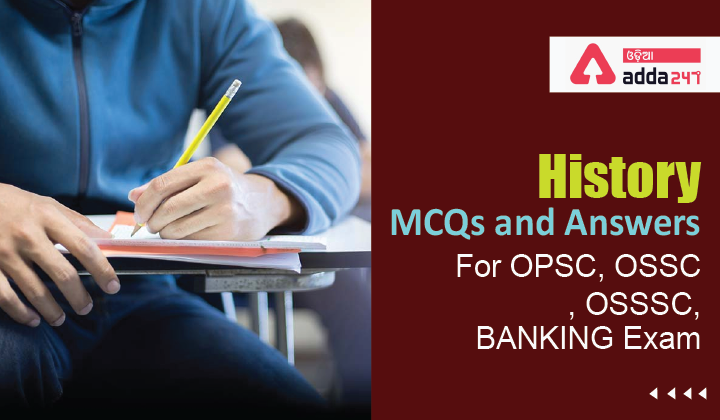History MCQs and Answers: History MCQs are very important for OPSC, OSSC, OSSSC & Other State Exams. Aspirants who are willing to apply for the various Government exams 2022 must go through the topics of History for competitive exams, as History is a key part of the syllabus.
Q1. Which of the following texts provides evidence that Prithvi raj III wanted to conquer the whole world?
(a) Tabgat-i-Nasiri
(b) Taj-ul-Massir
(c) PrithvirajRaso
(d) PrithvirajPrabandha
S1.Ans.(c)
Sol. The PrithvirajRaso is a Brajbhasha epic poem about the life of the 12th century Indian king Prithviraj Chauhan. It is wriiten by Chand Bardai, who according to the text was a court poet of the king.
Q2. The renowned Temple at Ranakpur is a _______ Temple.
(a) Shiva
(b) Jain
(c) Krishna
(d) Ram
S2. Ans.(b)
Sol.
The renowned Jain temple at Ranakpur is dedicated to Tirthankara Rishabhanatha.
Q3. The main collections of vedic hymns are called?
(a) Pad
(b) Sutra
(c) Samhita
(d) Mukh
S3.Ans(c)
Sol. The main collections of vedic hymns is called Samhita.
Q4. What was the name of the movement started by Khan Abdul Ghaffar Khan against British?
(a) Red Shirt
(b) Quit India
(c) Khilafat
(d) None of these
S4. Ans.(a)
Sol.The Lal Kurti or Red Shirt Movement was launched by Abdul Ghaffar Khan in 1930–31 against British East India Company.
It is also known as the “KhudaiKhidmatgar” Movement.
KhudaiKhidmatgar is a Persian word that means in Hindi ‘Servant of God’.
Download ADDA247 Odia APP – Appear Latest Exam Test Series & Live Classes
Q5. The Permanent settlement introduced by Cornwallis is in Bengal is known as
(a) Roytwari System
(b) Mahalwari System
(c) Zamindari System
(d) Iqtadari System
S5.Ans.(c)
Sol. Permanent settlement was introduced in 1793 by Lord Cornwallis and covered around one fifth of British territory in India, including Bengal, Bihar, Orissa, parts of Northern Karnataka, Varanasi and some other areas. There is a middlemen in this system who were the Zamindars, who need to pay a fixed amount of land revenue on a fixed date every year.It is also called Zamindari System.
Q6. Jallikattu is associated with _____.
(a) Trichur
(b) Karthigai
(c) Onam
(d) Pongal
S6. Ans.(d)
Sol.
Jallikattu (or sallikkattu), also known as eruthazhuvuthal and manjuvirattu, is a traditional spectacle in which a Bosindicusbull.Jallikattu is typically practised in the Indian state of Tamil Nadu as a part of Pongal celebrations on Mattu Pongal day, which occurs annually in January.
Q7. Quit India Movement was launched by Mahatma Gandhi in _____.
(a) 1885
(b) 1942
(c) 1947
(d) 1939
S7. Ans.(b)
Sol.
The Quit India Movement or the India August Movement, was a movement launched at the Bombay session of the All-India Congress Committee by Mahatma Gandhi on 8 August 1942, during World War II, demanding an end to British Rule of India.
Q8. In the Constituent Assembly, when was the ad-hoc Committee appointed for the National Flag—
(a) 22th June 1947
(b) 22th July 1947
(c) 22th Jan. 1947
(d) 22th Feb. 1947
S8. Ans.(b)
Sol. Dr. Rajendra Prasad was the head of the Ad hoc committee on National Flag in the constituent assembly. The flag of the congress party was accepted as the National Flag with few changes on July 22, 1947.
Q9. Who rendered the English translation of the Indian National song?
(a) Shri Aurobindo
(b) RabindraNath Tagore
(c) B.C. Chatterjee
(d) Sarojini Naidu
S9. Ans.(a)
Sol. VandeMataram, a poem from Bankim Chandra Chattopadhyay’s 1882 novel Anandamath, is the national song of India. Aurobindo Chose translated it into English. The literal translation of all the stanzas of VandeMataram by AurobindoGhose appeared in Karmayogin, 20 November, 1909.

Q10. Who among the following was the President of Indian National Congress continuously for six years during Indian National Movement?
(a) Jawaharlal Nehru
(b) AbulKalam Azad
(c) G.K. Gokhale
(d) DadabhaiNaoroji
S10. Ans.(b)
Sol. Abdul Kalam Azad was the longest serving President of Congress during Indian National Movement.
He served as Congress president from 1940 to 1945.
During his tenure as President of Congress the QuitIndia rebellion was launched and British Raj.
Q11. Among the following whose tomb is located outside India?
(a) Humayun
(b) Aurangzeb
(c) Jahandar Shah
(d) Jahangir
S11. Ans.(d)
Sol. Tomb of Mughal Emperor Jahangir is located outside of India.
It is located in ShahdaraBagh in Lahore,Pakistan, along the banks of the Ravi River.
Q12. According to Mahatma Gandhi the British rule in India was established
(a) By using force
(b) By other foreign powers
(c) Without the co-operation of Indians
(d) With the co-operation of Indians
S12. Ans.(d)
Sol. Mahatma Gandhi in his book Hind Swaraj describes that British rule was established in India with the cooperation of Indians and if they had refused to cooperate, British rule in India would have been collapsed within a year.
Q13. Who is the author of the book ‘My experiments with Truth’?
(a) Michael Anderson
(b) James Morris
(c) Mahatma Gandhi
(d) Winston Churchill
S13.Ans.(c)
Sol. The Story of My Experiments with Truth is the autobiography of Mohandas K. Gandhi, covering his life from early childhood through to 1921. It was written in weekly instalments and published in his journal Navjivan from 1925 to 1929. Its English translation also appeared in installments in his other journal Young India.
Q14. Who is the author of the book ‘Glimpses of World History’?
(a) Jawaharlal Nehru
(b) AbulKalam Azad
(c) S. Gopalan
(d) S. Radhakrishnan
S14.Ans.(a)
Sol. Glimpses of World History, a book published by Jawaharlal Nehru in 1934, is a panoramic sweep of the history of humankind. It is a collection of 196 letters on world history written from various prisons in British India from 1930–1933.
Q15. In which of the following session of Indian National Congress, Subhash Chandra Bose was elected as President for the second time?
(a) Haripura Session
(b) Madras Session
(c) Tripuri Session
(d) Calcutta Session
S15. Ans.(c)
Sol. In Haripura session of Indian National Congress, Subhash Chandra Bose was elected as President of Congress for thefirst time in 1938.
He was reelected for the post in 1939 at Tripuri Session of the Congress, but this time he was opposed by Gandhi, Because Gandhi supported Dr. Pattabhi Sitaramayya, Hence, Subhash Chandra Bose, resigned from the post.
History MCQs and Answers For OPSC, OSSC, OSSSC Exam
Geography MCQs and Answers For OPSC, OSSC, OSSSC Exam
General Science MCQs and Answers For OPSC, OSSC, OSSSC, BANKING Exam
Polity MCQs and Answers For OPSC, OSSC, OSSSC, BANKING Exam
Odisha Geography MCQs and Answers For OPSC, OSSC, OSSSC Exam








